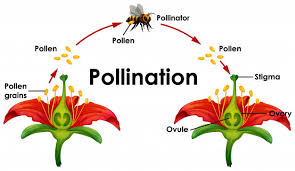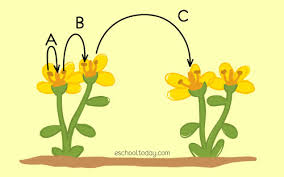WHAT IS POLLINATION- PROCESS & MECHANISM
Definition
The transfer of pollen grains from male part of a plant (Anther) to female part of the plant (Stigma) is called pollination. Later fertilization takes place and seed is produced.
Pollinators Or Pollen Vectors
Pollination is accomplished by pollinators, who carry the pollens, such as insects, birds, water, wind and rain that can be termed as pollen vectors.
In other words, we can also say that pollination may be biotic or abiotic, because biotic pollination depends on living pollinators, such as insects; and abiotic pollination relies on wind or water.
- Anemophily- pollination by wind, about 98% abiotic pollination is anemophily.
- Hydrophily- by water is called hydrophily.
- Entomophily- by insects.
- Zoophily- pollination is performed by vertebrates such as birds and bats.
- Ornithophily- by birds

PROCESS OF POLLINATION
The germination of pollen has 3-stages which are defined here.
- Hydration– initially pollens are dehydrated, while germination takes place after re-hydration of pollen grains ensuring that premature germination does not take place in the anther. It allows the plasma membrane of the pollen grain to reform into its normal bi-layer structure providing an effective osmotic membrane.
- Activation– Activation involves the development of protein micro-filaments throughout the cytoplasm of the cell, which eventually become concentrated at the point from which the pollen tube will emerge. Hydration and activation continue as the pollen tube begins to grow.
- Emergence of pollen tube– pollen tubes are produced by the male gametophyte of the seed plants, transport the male gamete cell from the pollen grains.
MECHANISM
Pollination is accomplished by self-pollination or cross-pollination. Let’s see the mechanism of both types-
- Self-pollination- when pollen from one flower pollinates the same flower or other flowers of the same plant, known as self-pollination.
- Autogamy– pollen is transferred to the female part of the same flower.
- Geitonogamy– when pollen is transferred to another flower of the same plant.
There are several mechanisms which promotes self-pollination. For example, some flowers open only after pollination, some don’t open at all etc.

- Cross-pollination– It occurs when pollen is transferred from the stamen of one flower to the stigma of a flower on another plant. There are several mechanisms which prevent self-pollination for example, the reproductive organs may be arranged in such a way that self-fertilization is unlikely, or the reproductive organs may mature at different times.
Read more…
REPRODUCTION IN PLANTS
CROSS POLLINATION- MECHANISM AND CONSEQUENCES
SELF POLLINATION- MECHANISM & CONSEQUENCES
PLANT HORMONES- FACTS, TYPES & EFFECTS
DIFFERENCE BETWEEN DIFFUSION AND OSMOSIS
WHAT IS ENZYME- NATURE AND PROPERTIES